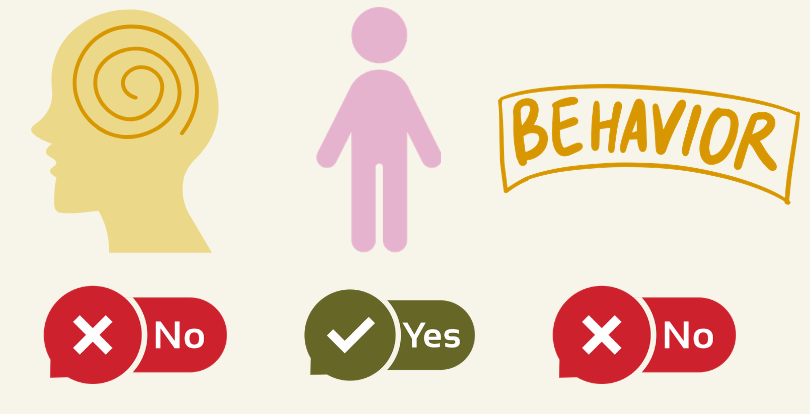Health behavior change gets so much easier when you begin to understand what your mind wants vs. what your body wants. You wants drive your behaviors but what if your mind and body want different things?
You don’t need self-control or motivation to change your behavior.
You need to understand what your body wants and what your mind wants.
This really hit me as I poured myself a bright green matcha that I really wished was coffee.
And yet, I’m not drinking coffee today, or any day (lately).
For five years, I’ve felt the pressure to avoid coffee for acid reflux. The first time I cut it out, in the middle of my (intense and headache ridden) withdrawal from caffeine, I wondered: Is this just who I actually am? All these years, was my motivation, hope, and drive simply because I was caffeinated? Listen, it got better (lol) but it felt so real to me at the moment!
My love for coffee is why it is so hard to make this behavior change stick. Back and forth I go - in seasons where my digestion is feeling particularly prickly I’ll give up coffee again and when things settle, I subtly escalate from stolen sips to my allotted half a cup. Comically, along the way, my body is now so sensitive to caffeine, I can’t have a whole cup without heart palpitations.
It is hard to give up something you love because your body asks you to stop. Wrestling between what we want vs. what our body wants can feel so tiring when we are just trying to take care of ourselves.
Let’s think of this polarization, for ease, like this:
What the mind wants to do (or not do)
What the body wants to do (or not do)
In general, deciphering what the mind wants tends to be a bit more straightforward: “I love coffee and I want to drink it”. There may be a mental narrative of “likes” and “dislikes” or emotions like boredom, dread, anticipation, avoidance, or excitement that help to shape our interest, or disinterest, in something.
The body communicates what it wants differently. My body does not want coffee: it tells me this with the racing of my heart and acid reflux.
Sensing and interpreting our body’s cues is called interoceptive awareness. Everyone’s ability to sense and perceive body sensations is completely unique.
If you’re new to the idea of tuning into body signals, check out this essay on interoceptive awareness, then come back here!
Feeling your inner world to guide your outer world: Interoceptive Awareness
In college, I went on a bad first date at Disney World.
It may seem harder to define the preferences of the body; here are a few health-related examples:
Ways a body might say yes:
Digestive comfort: regular bowel movements, neutral sensations after eating, hunger
Physical ease: relaxed muscles, lack of soreness, long deep breaths, a sense of contentment
Energy cues: Feeling energized, clear-headed, sleepiness around bedtime
Absence of discomfort: No pain, no acid reflux, no racing heartbeat
Ways a body might say no:
Digestive distress: constipation/diarrhea, irregular bowel movements, stomach pain, painful bloating, acid reflux
Emotional discomfort: anxiety, overwhelm, irritability
Stress signals: heart palpitations, shallow breathing, tension in your belly
Musculoskeletal tension: low back pain, hip aches, muscle tightness, tension headaches
As my clients build awareness of what their body wants/likes/dislikes and what their mind wants/likes/dislikes, behavior change becomes more doable.
It is more doable because they can break apart the different sensations and feelings they have about any particular behavior change. In short, they “get it”. What a relief it is to feel more clarity with one’s body and mind! “Getting it” means more acceptance, gaining clarity on what actions to take to support yourself, and exploring different parts of you related to behavior change.
Dissecting your preferences
Step One:
Practice noticing and naming the preference of your mind and the preference of your body. If noticing your body is new, pause here and begin to sense your body more often; this essay has some ideas of how to do this. This type of inquiry can take time to gain understanding so be patient with yourself!
Step Two:
From noticing, we translate the preferences into action. Now, whether or not you are aware, you certainly are already taking actions! But for the sake of these examples, we’ll imagine there are body + mind preferences that you are now aware of.
Considering the mind’s preference, body’s preference and what actually takes place, there are a few different different combinations that could be experienced--we’ll explore a few below.
To keep the next section more simple, I am going to use the phrases “Yes” and “No” to imply the preference of the mind and body. I also use the phrase “Behavior”: “Yes” or “No” to capture whether or not a health behavior takes place.
You will be able to explore different combinations of preferences and identify specific tools to support you based on the specific combination.
Experience 1: Mind + Body say YES
This experience is wonderful! Likely, behaviors feel attuned, somewhat “easy” or maybe effortless. They probably require very little external “convincing” to get you to do them.
Examples:
Getting a massage
Taking a post-lunch walk
Moving your body in a way you enjoy
Getting into bed when you are sleepy
Tools: Likely, little support is needed. Note if behaviors stop happening, a first step is exploring what has changed to prevent the behaviors from happening.
This experience is more complicated. Most commonly, this circumstance arises when folks avoid behaviors they like or that feel good due to over-scheduling, lack of access, fatigue, their body’s ability, finances, etc.
Examples:
Loving yoga, but lacking funds to afford a class, or time to attend a class
Feeling exhausted but needing to stay awake to work
Love for home cooked, nutrient-dense meals, but work schedule interrupts a meal time
Tools:
Setting boundaries with family or friends
Scheduling time for behaviors
Asking for help
Get as specific as you can with what gets in the way of the health behavior as it is likely outside of you. One caveat may be a physical symptom like fatigue - if that is the case, explore what could be contributing to fatigue or other physical symptom.
Be honest with the time you have, and utilize convenience items when you can to help make the behavior happen (examples: shorter workouts, pre-chopped veggies, etc.).
This is not a circumstance where someone “lacks motivation”, rather, external factors impact one’s ability to engage in a behavior they like. Because of this, accountability or other “motivating” strategies may feel less relevant. Focus on your individual barriers and see what solutions are present in your life.
Experience 2: Mind says NO, body says YES
Next, let’s explore the experience of the mind NOT wanting to do the behavior. If you are recently diagnosed with a disease with new behavior change recommendations, this experience may be one you are familiar with. This might sound like “I don’t want to pay attention to saturated fat intake” or “I don’t like physical activity” or “I don’t want to go to bed!”. This type of behavior is the hardest to source internal motivation to do (and can benefit the most from “behavior change” strategies).
This experience likely requires some external support to make it happen. When the mind doesn’t want to do something, using behavior change strategies like habit stacking can help make it feel easier for the mind to say yes.
Examples:
Completing physical therapy exercises to reduce knee pain (even if you hate it)
Going on a morning walk even if you are tired
Eating a serving of vegetables even if it’s not your favorite food
This experience of behavior change is one our culture idealizes. Oh you hate exercise but you do it anyway? You are a superstar of self-control. I have a lot of issues with this mindset, but just know, it is okay if you need a lot of help to make behavior change happen!
Examples:
Not completing physical therapy exercises despite knee pain. The mind might avoid a behavior through forgetfulness, struggle to fit it into a schedule, or dismissing it.
Not going to bed on time due to revenge bedtime procrastination
Tools: If this combination presents itself in your life, spend time journaling to understand why your mind doesn’t like the behavior. From there, you can implement some behavior change tools to help you accomplish the behavior (if you decide you want to):
Identify alternative “actions” that get you similar benefits (i.e. if you hate running, try biking)
Answer the question, “What could make it 1% easier to say yes to this behavior?”
Source accountability with a friend or movement class registration
Link the undesirable action with something you enjoy
Create a routine rather than rely on motivation (motivation and self-control are fleeting!)
Outsource the “labor” of the task - such as purchasing pre-chopped veggies
Hire support: a health educator, behavior change coach, dietitian, or therapist
Most importantly, have compassion for yourself! It is challenging to pursue actions we don’t want to do! You can learn from all of your experiences, what works, and what doesn’t!
Experience 3: Mind says YES, body says NO
This is an important experience to explore as it also captures an essence of the lived experiences of addiction and eating disorders.
This experience can feel intense: a strong desire to do something alongside the body telling you not to. Likely, since the body is saying no, there may be consequences of the behavior.
Examples:
Using alcohol to relax (Consequence: the body might experience poor sleep/hangover symptoms)
Drinking caffeine in the afternoon (Consequence: sleep interruption)
Restriction (Consequence: hyper-fixation on food, extreme hunger, risk for binging increased)
Smoking, excessive screen time, or drug use (Consequence: addiction or extreme difficulty discontinuing the behavior)
It is very challenging to NOT do something the mind wants to do for the sake of taking care of the body. Offering yourself so much space to make mistakes, learn from them, and implement tools to help you is crucial for this experience. Likely creating sustainable patterns that help you honor your body’s cues will lead to improved well-being.
Examples:
Avoiding coffee because it upsets your stomach
Begrudgingly following a gluten free diet if you have Celiac disease
Urge surfing instead of purging
Quitting smoking
There can be a lot of internal conflict in this type of experience because the mind’s preferences are often louder than the body’s preferences. The mind can convince us to do a lot of things that our body really doesn’t want us to do or will actively harm the body.
Tools:
Support groups like AA, NA, eating disorder treatment
Identify alternative behaviors you can engage in instead of the one your body doesn’t want.
Increase your awareness of environments or circumstances that trigger desire to engage in a behavior the body doesn’t like.
Practice mindfulness techniques and learn strategies to support your nervous system
Source professional support from a dietitian, therapist, or medical team (and tools like medications)
Equipping yourself with the knowledge of what your mind wants and what your body wants will absolutely transform the approach you take to change your behaviors.
Most importantly: your actions, and what informs them, is 100% unique to you; no external rules required.
Motivation and self-control are not the ultimate answers to accomplishing health behaviors. As we outlined above, sometimes the issue isn’t motivation, it’s having enough time. Sometimes the challenge isn’t self-control, it’s addiction. It isn’t that you don’t care about your health, it’s that you are burning the candle at both ends.
This framework is a portal to being kind to yourself about the reality of your experience and taking steps to care for yourself, one want at a time.
If you are looking for further ways to connect, I’d love to hear from you!
💭Are you curious about 1:1 nutrition counseling? Schedule a Free Discovery Call.
🫱🏻🫲🏼Are you a eating disorder professional seeking supervision? Schedule a Free Discovery Call to learn about my supervision support.
👩🏼💻I write another newsletter for RDs & private practice owners; subscribe here.


















